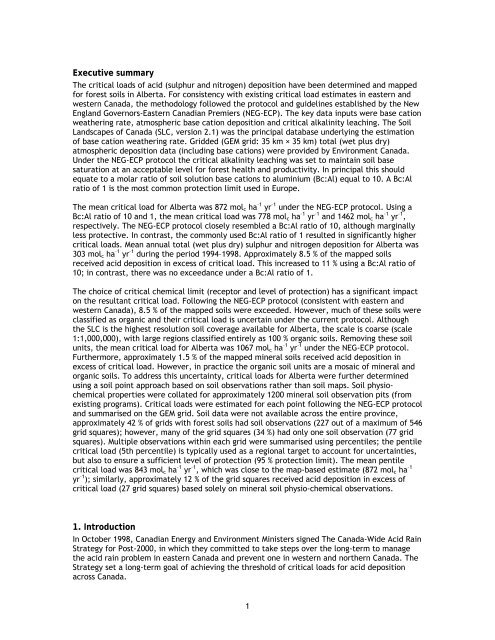calculating critical loads of acid deposition for forest soils in ... - CCME
calculating critical loads of acid deposition for forest soils in ... - CCME
calculating critical loads of acid deposition for forest soils in ... - CCME
You also want an ePaper? Increase the reach of your titles
YUMPU automatically turns print PDFs into web optimized ePapers that Google loves.
Executive summary<br />
The <strong>critical</strong> <strong>loads</strong> <strong>of</strong> <strong>acid</strong> (sulphur and nitrogen) <strong>deposition</strong> have been determ<strong>in</strong>ed and mapped<br />
<strong>for</strong> <strong>for</strong>est <strong>soils</strong> <strong>in</strong> Alberta. For consistency with exist<strong>in</strong>g <strong>critical</strong> load estimates <strong>in</strong> eastern and<br />
western Canada, the methodology followed the protocol and guidel<strong>in</strong>es established by the New<br />
England Governors-Eastern Canadian Premiers (NEG-ECP). The key data <strong>in</strong>puts were base cation<br />
weather<strong>in</strong>g rate, atmospheric base cation <strong>deposition</strong> and <strong>critical</strong> alkal<strong>in</strong>ity leach<strong>in</strong>g. The Soil<br />
Landscapes <strong>of</strong> Canada (SLC, version 2.1) was the pr<strong>in</strong>cipal database underly<strong>in</strong>g the estimation<br />
<strong>of</strong> base cation weather<strong>in</strong>g rate. Gridded (GEM grid: 35 km × 35 km) total (wet plus dry)<br />
atmospheric <strong>deposition</strong> data (<strong>in</strong>clud<strong>in</strong>g base cations) were provided by Environment Canada.<br />
Under the NEG-ECP protocol the <strong>critical</strong> alkal<strong>in</strong>ity leach<strong>in</strong>g was set to ma<strong>in</strong>ta<strong>in</strong> soil base<br />
saturation at an acceptable level <strong>for</strong> <strong>for</strong>est health and productivity. In pr<strong>in</strong>cipal this should<br />
equate to a molar ratio <strong>of</strong> soil solution base cations to alum<strong>in</strong>ium (Bc:Al) equal to 10. A Bc:Al<br />
ratio <strong>of</strong> 1 is the most common protection limit used <strong>in</strong> Europe.<br />
The mean <strong>critical</strong> load <strong>for</strong> Alberta was 872 mol c ha –1 yr –1 under the NEG-ECP protocol. Us<strong>in</strong>g a<br />
Bc:Al ratio <strong>of</strong> 10 and 1, the mean <strong>critical</strong> load was 778 mol c ha –1 yr –1 and 1462 mol c ha –1 yr –1 ,<br />
respectively. The NEG-ECP protocol closely resembled a Bc:Al ratio <strong>of</strong> 10, although marg<strong>in</strong>ally<br />
less protective. In contrast, the commonly used Bc:Al ratio <strong>of</strong> 1 resulted <strong>in</strong> significantly higher<br />
<strong>critical</strong> <strong>loads</strong>. Mean annual total (wet plus dry) sulphur and nitrogen <strong>deposition</strong> <strong>for</strong> Alberta was<br />
303 mol c ha –1 yr –1 dur<strong>in</strong>g the period 1994–1998. Approximately 8.5 % <strong>of</strong> the mapped <strong>soils</strong><br />
received <strong>acid</strong> <strong>deposition</strong> <strong>in</strong> excess <strong>of</strong> <strong>critical</strong> load. This <strong>in</strong>creased to 11 % us<strong>in</strong>g a Bc:Al ratio <strong>of</strong><br />
10; <strong>in</strong> contrast, there was no exceedance under a Bc:Al ratio <strong>of</strong> 1.<br />
The choice <strong>of</strong> <strong>critical</strong> chemical limit (receptor and level <strong>of</strong> protection) has a significant impact<br />
on the resultant <strong>critical</strong> load. Follow<strong>in</strong>g the NEG-ECP protocol (consistent with eastern and<br />
western Canada), 8.5 % <strong>of</strong> the mapped <strong>soils</strong> were exceeded. However, much <strong>of</strong> these <strong>soils</strong> were<br />
classified as organic and their <strong>critical</strong> load is uncerta<strong>in</strong> under the current protocol. Although<br />
the SLC is the highest resolution soil coverage available <strong>for</strong> Alberta, the scale is coarse (scale<br />
1:1,000,000), with large regions classified entirely as 100 % organic <strong>soils</strong>. Remov<strong>in</strong>g these soil<br />
units, the mean <strong>critical</strong> load <strong>for</strong> Alberta was 1067 mol c ha –1 yr –1 under the NEG-ECP protocol.<br />
Furthermore, approximately 1.5 % <strong>of</strong> the mapped m<strong>in</strong>eral <strong>soils</strong> received <strong>acid</strong> <strong>deposition</strong> <strong>in</strong><br />
excess <strong>of</strong> <strong>critical</strong> load. However, <strong>in</strong> practice the organic soil units are a mosaic <strong>of</strong> m<strong>in</strong>eral and<br />
organic <strong>soils</strong>. To address this uncerta<strong>in</strong>ty, <strong>critical</strong> <strong>loads</strong> <strong>for</strong> Alberta were further determ<strong>in</strong>ed<br />
us<strong>in</strong>g a soil po<strong>in</strong>t approach based on soil observations rather than soil maps. Soil physiochemical<br />
properties were collated <strong>for</strong> approximately 1200 m<strong>in</strong>eral soil observation pits (from<br />
exist<strong>in</strong>g programs). Critical <strong>loads</strong> were estimated <strong>for</strong> each po<strong>in</strong>t follow<strong>in</strong>g the NEG-ECP protocol<br />
and summarised on the GEM grid. Soil data were not available across the entire prov<strong>in</strong>ce,<br />
approximately 42 % <strong>of</strong> grids with <strong>for</strong>est <strong>soils</strong> had soil observations (227 out <strong>of</strong> a maximum <strong>of</strong> 546<br />
grid squares); however, many <strong>of</strong> the grid squares (34 %) had only one soil observation (77 grid<br />
squares). Multiple observations with<strong>in</strong> each grid were summarised us<strong>in</strong>g percentiles; the pentile<br />
<strong>critical</strong> load (5th percentile) is typically used as a regional target to account <strong>for</strong> uncerta<strong>in</strong>ties,<br />
but also to ensure a sufficient level <strong>of</strong> protection (95 % protection limit). The mean pentile<br />
<strong>critical</strong> load was 843 mol c ha –1 yr –1 , which was close to the map-based estimate (872 mol c ha –1<br />
yr –1 ); similarly, approximately 12 % <strong>of</strong> the grid squares received <strong>acid</strong> <strong>deposition</strong> <strong>in</strong> excess <strong>of</strong><br />
<strong>critical</strong> load (27 grid squares) based solely on m<strong>in</strong>eral soil physio-chemical observations.<br />
1. Introduction<br />
In October 1998, Canadian Energy and Environment M<strong>in</strong>isters signed The Canada-Wide Acid Ra<strong>in</strong><br />
Strategy <strong>for</strong> Post-2000, <strong>in</strong> which they committed to take steps over the long-term to manage<br />
the <strong>acid</strong> ra<strong>in</strong> problem <strong>in</strong> eastern Canada and prevent one <strong>in</strong> western and northern Canada. The<br />
Strategy set a long-term goal <strong>of</strong> achiev<strong>in</strong>g the threshold <strong>of</strong> <strong>critical</strong> <strong>loads</strong> <strong>for</strong> <strong>acid</strong> <strong>deposition</strong><br />
across Canada.<br />
1
















